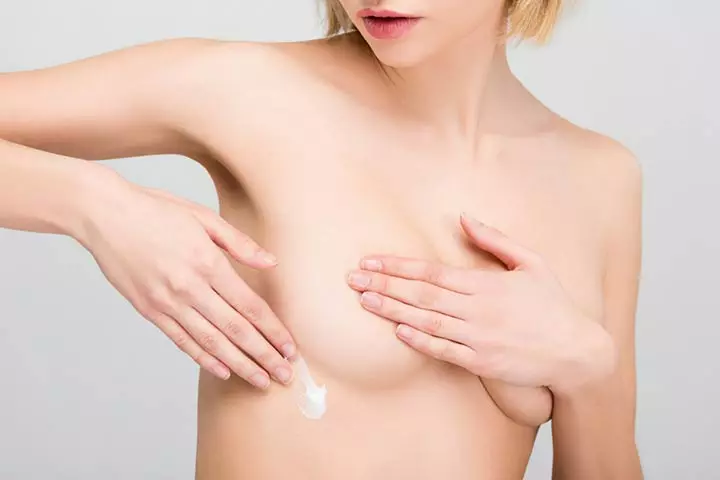
Image: Shutterstock
For many women, breastfeeding may not be convenient at all times. For those spending time away from their babies, breastfeeding just might not be possible. This is especially true for office goers and working mothers. But even for stay-at-home moms, feeding all the time can become overwhelming at some point. Breast pumps are a great way to store your milk to be used later. Having bottles of your milk ready in feeding bottles would make sure that your baby is meeting the nutritional needs even when you’re not able to breastfeed them. However, the experience of using breast pumps varies from woman to woman. For some, it is good and easy, while others may find it hard, and in some cases, even painful.
For those who are finding the use of breast pumps too difficult or painful, the experience can definitely be improved with some small adjustments. Let’s look at some of these tips:
1. Find The Right Breast Pumps
There’s a wide variety of breast pumps out there and you’ll have to find one that best suits your needs. The two main types would be the manual and the powered types. The good old manual breast pumps are a great option but all the pumping action may leave you tired after a while. The powered pumps come to the rescue here. Be it electrically powered or battery-powered, it takes care of the pumping action saving your precious energy. For those constantly on the move, battery-powered pumps are a great portable option. Other variations include electrical rechargeable breast pumps and hospital-grade breast pumps. Also, make sure that you get one that is your size, as the one-size-fits-all doesn’t work with breast pumps.
2. Plan It Well In Advance
Next, you will have to understand the feeding cycle of your little one and plan your pumping sessions accordingly. Breast milk can be stored for up to 24 hours in refrigerated conditions (4-10 degrees Celsius) (1). This gives you some time to plan the feeding for the day ahead. Storing the required amount of milk for the day would relieve you of your feeding duties while also keeping the baby happy.
3. Pump And Breastfeed At The Same Time
When you breastfeed, your body sends signals to produce more milk. It may help to use the breast pump while you are breastfeeding your little one. You’ll notice that you can express more milk than usual when you do this, as hormones will be produced to trigger the production of more milk as your baby is drinking (2). This will also save you some time by not having to spend time pumping separately.
4. Give Your Breasts A Massage
Massaging your breasts can help with the soreness, but more importantly, it can help maximize milk production (3). Make sure you gently massage your breasts in the areas where you can feel a certain amount of hardness. Consider giving yourself a gentle massage two or three minutes before you start pumping your breasts. After finishing the pumping, give your breasts a last short round of caressing and gentle massage for a minute or two.
5. Try The “Massage, Shake, Stroke” Approach
The idea behind this approach is to help you express milk or breastfeed with ease. It is beneficial for lactating mothers who notice problems with their milk supply. First, you need to gently massage your breasts in a circular motion. You’ll have to do this for a few minutes. Then, gently stroke your breasts in the direction from the wall of your chest to the nipple. Keep doing this for a few minutes. Then, you’ll have to lean forward and gently shake your breast — you’re basically letting gravity help you by leaning forward. Do this at least twice or thrice a day when you are lactating (4).
6. Check Your Breast Pumps
Often, the problem is not with your milk supply but with the flanges in your breast pumps. Ill-fitting flanges that are too loose or too tight can affect the flow of milk that you express. Or sometimes, it can be because the membranes in the breast pumps are ripped, or the pump has some defect. It is recommended to change the flanges at least once in three months.
7. Keep The Pumps Clean
Keeping your breast pump clean isn’t just a matter of hygiene and safety; it can also help keep the pumps in a good, longer-lasting condition. The last thing you want is your baby catching an infection because you forgot to clean the pumps. You can boil the suction parts of the pump in hot water before use, but make sure you check the user manual to see if this can be done without damaging the pump. It may help to buy two breast pumps so you can alternate between the two.
8. Moisturize Your Breasts
All that breastfeeding and pumping can result in sore or cracked nipples. Luckily, there are some great nipple creams available, so you can gently apply them to your breasts and nipples. Look for brands that are chemical-free and natural. Apply them at night when your baby is done feeding. Ensure you wash your breasts before you feed your child or express the milk to avoid ingestion of these creams.
9. Create A Routine, And Stick To It
When we say create a routine, we mean that you could create a pattern of the things you need to do while expressing milk. For example, before you sit down to pump your breasts, get yourself a glass of water, maybe even a book. Make yourself comfortable; make sure that you won’t be interrupted. Block a particular time during the day when you will not be distracted. As the habit starts setting in, your body will respond better in producing milk.
It’s essential to be patient when you use a breast pump. At first, it may hurt, and you may notice that the supply of milk is not a lot. With time, patience, and the tips we’ve mentioned above, you’ll find it easier to express milk with breast pumps. What are your thoughts on this? Let us know in the comments below!
References
- Storage Of Breast Milk: Effect Of Temperature And Storage Duration On Microbial Growth
https://pubmed.ncbi.nlm.nih.gov/11320771/ - The Physiological Basis Of Breastfeeding
https://www.ncbi.nlm.nih.gov/books/NBK148970/ - Effectiveness Of Breast Massage For The Treatment Of Women With Breastfeeding Problems: A Systematic Review
https://pubmed.ncbi.nlm.nih.gov/31135656/ - The Effectiveness of Massage Therapy for Improving Sequelae in Post-Stroke Survivors. A Systematic Review and Meta-Analysis
https://www.ncbi.nlm.nih.gov/pmc/articles/PMC8122530/




















